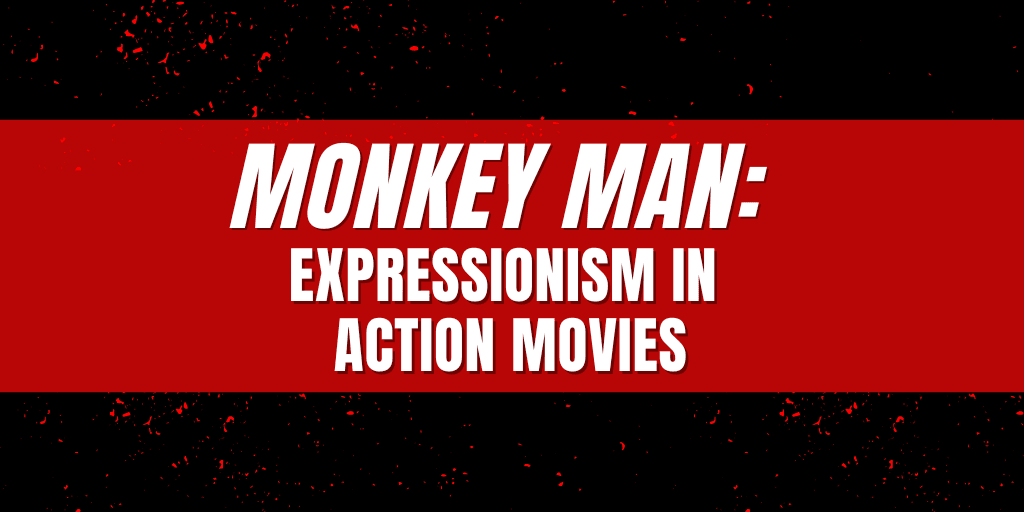This week we’re going to be studying Monkey Man, the new Dev Patel movie. With a screenplay by Paul Angunawela and John Collee, story by Dev Patel.
This is a special film for me because one of our students, Joseph J.U. Taylor, has a wonderful small role in the piece. We’re really proud of you, Joseph.
I do want to warn you that there will be some moderate spoilers in the first half of the movie. We’re definitely going to spoil the sea change (the midpoint of the film), but I’ll give you a heads up before we get into where it all goes.
Our focus today is on the epic scope of Monkey Man and how it uses the power of action movies to deliver something much more profound than your typical popcorn movie. We’ll be discussing the difference between naturalism and expressionism in all kinds of movies. We’ll be discussing a profoundly important element of 7 Act Structure called The Sea Change and how it functions in Monkey Man And we’ll also be examining a small but significant moment that demonstrates how to create a sense of reality and fully realized characters, even within such a heightened, action-packed, expressionistic piece.

Many people have described Monkey Man as essentially John Wick in India. It’s a giant, bloody, revenge fantasy told through almost non-stop action sequences.
In many ways, that is what Monkey Man is.
It’s like so many Quentin Tarantino movies. It’s like Kill Bill, with its larger than life action sequences that are almost expressionistic in their nature.
So, what exactly is expressionism? And how does it differ from realism and naturalism in film?
Realism means that the film is playing out almost exactly the way things do in real-time.
A weird thing happens if you actually hang out in realism in films, which is that realism doesn’t feel real.
Movies move faster than real life. They have to because they only have an hour and a half, maybe two hours, to tell a story that, if you were just gonna retell it beat by beat, would feel like forever.
Most movies actually don’t take place in realism. They take place in naturalism.
In other words, they take place in a heightened, faster, more extreme reality that feels like it’s real, but it’s actually happening at a high-pitched pace.
In reality, half of our language is:
“Hey, how you doing?”
“Good, good. How you doing?”
Half of our language is not even connected.
Half of our language isn’t doing anything.
There’s no want, there’s no need. Half the time we’re not even making choices.
“I really should… but I don’t want to… but I’m not ready to… but I want to… I should…”
That’s realism.
We’re in these states of limbo most of our lives, in which every now and then we have those punctuating moments like, “bang, this matters.”
So if we really were to write in the world of realism, we would have all those boring moments and end up with a diffuse storytelling in which it’s hard to actually capture the journey in the short period of time we have.
Of course, in TV we have even less time. Even though we have more episodes, the episodes are even shorter. So both movies and TV tend to happen in the world of naturalism.
What naturalism means is that the volume is turned up. All the stuff that doesn’t really matter, the stuff that’s not vital to the storytelling, is cut out. We’re left with only those moments that matter. We’re left with only that great line.
In real life, you’re hanging out with somebody, they say something funny and two hours later you’re like, “I know what I should have said!”
In naturalism, they say the funny thing, and then we say the funny thing, and then they say the funny thing that topped that. As a writer, maybe it took you days to figure that out. But on the screen, it feels like it’s just happening. We get this more pure version of who the character is.
Most action movies (like Monkey Man) don’t actually take place in naturalism. They take place in expressionism, meaning the story we are watching does not feel like literal reality. It’s more of an expression what does that reality feels like on the inside.
In traditional Hollywood popcorn movies, that’s people making jokes while they fight. That’s people being able to hold on to a ledge by one pinky.
This kind of stuff is not real. Even The Rock is not that tough! But the character feels that tough. It’s an expression– not a naturalistic expression, but a heightened expression– of what it feels like on the inside.
Often we see expressionism in art films, and we see expressionism in action movies. It’s one of the weird places where they actually connect.
But what Dev Patel is doing in Monkey Man is using expressionism to do something different. Monkey Man is not a feel-good Hollywood popcorn movie. Dev Patel is using expressionism to look at class in India.
Dev Patel is looking at the unfairness of the situation, the way he sees it. He’s actually using the power of the action movie to enfold a political commentary.
I think this is a profound choice.
While some “serious” writers turn up their noses at action movies, but I think that’s a mistake. These are the movies that everybody sees, which means there’s a great potential within these action films (if done right) to change peoples perceptions, and with them, to change the world.
There’s a great legacy of this, with action franchises like Planet of the Apes, X-Men, and Guardians of the Galaxy – all wonderful action movies that take place in expressionism and have a political element to them.
Unlike a traditional action movie, which is usually going to start almost like a TV show, with a cold open that’s filled with action, Monkey Man starts in a spiritual way.
It starts with a mother telling her son the story of Hanuman. Hanuman, of course, is the monkey god in Hinduism.
The story of Hanuman, the way she tells it, is that he became enthralled by this beautiful mango, and he wanted to eat it, and he didn’t realize that what he was actually reaching for was the sun. He was reaching for something bigger than him, and because of his hubris, the gods then punished him and took away his power.
At the center of Monkey Man is Dev Patel’s character, the Kid, who is the embodiment of that version of Hanuman. He’s a man who fights in a monkey mask, and he’s a man who gives away his power. He’s been punished societally because of his poverty, because of his background. Terrible things have happened to his mother, and there is nothing that he can do about it– or so it seems.
Even in his career as a fighter, his job is not to win. His job is to bleed. His job is to give away his power and allow the more privileged fighters– the ones that people love– to win.
So there’s a connection between the two. There’s a story of Hanuman reaching too high and losing his power– having his power taken unfairly away from him. And there’s a story of the Kid having his power taken away from him.
There’s the metaphor of the caste system in India, which, even though technically outlawed, still exists economically and societally in so many ways. You’re not allowed to reach for the sun. You’re not allowed to reach for the mango. You’re not allowed to reach for the thing you want.
For the kid, the mango, the thing that he is reaching for, is revenge. He wants revenge against two men: One is a famous guru who manipulating the populace to increase his own political power, his own violence, through the teachings of Hinduism, using religion for control. The other is a corrupt police officer.
These two men are responsible for what happened to the Kid’s mother. Which, without spoiling too much, was not good.
So from the very beginning of Monkey Man, we have these little vignettes, these little flashbacks of these larger than life, beautiful experiences with the Kid’s mother. Again, these are not happening in the world of naturalism.
We’re not seeing mom get angry and ask The Kid to do his chores. We’re only seeing this heightened, beautiful version of mom. Mom, the way that the Kid remembers, dreams of, idealizes her. The way she feels to him on the inside, externalized in film.
These are the haunting memories that are with him, and they are driving his desire for revenge. That is the mango that The Kid is reaching for.
The Kid gets a job at an extremely high-end brothel, where, through all kinds of manipulations and machinations, he manages to get himself in a position where he can take his revenge. We’ve been waiting for it, and we know what’s coming, and we are rooting for him.
That brings us to the Sea Change of Monkey Man. For those of you who haven’t studied 7 Act Structure, sea change is what Syd Field would call “the midpoint.” But it does so much more than just serve as a midpoint.
You can think of your Sea Change like this: for the first half of your film, you are rolling the tide in as far as you can. In this case, the tide is rolling in towards a well-planned revenge against some really bad people.
In the second half of your film, you’re rolling the tide back out over the same landscape to see how everything has changed.
So through a bunch of schemes and machinations and brilliant plans and a little bit of luck, The Kid finally finds himself in a position where he can take his revenge. We get these awesome action sequences…
And it does not work.
This is the first lesson that I want you to take from Monkey Man. You understand naturalism. You understand expressionism. But structure means being willing to take away the thing that your character wants.
For this character, everything’s been building towards revenge. We’ve been waiting for revenge.
We’re about halfway through the movie and bang! Instead of getting revenge, we get the opposite.
Instead of getting revenge, everything goes wrong and then everything goes wronger and then everything goes even wronger.
Rather than getting the revenge he sought, The Kid barely escapes with his life.
Now we’re at a place where Monkey Man can start to pivot. All the things we expected to happen have happened. So what the heck happens now?
Well, that’s where the excitement comes from– not from the things we’re planning, but from the things we’re not planning, the things we’re not expecting, the things that we are unprepared for. That’s what you really want to be building as a screenwriter.
Of course, that’s also scary as a writer. It’s scary because a part of you is wondering: what if you can’t figure out how to get him out of this? What if you can’t figure out what happens?
But that’s also where the fascination lies. So don’t be afraid to make it worse and worse and worse. Don’t be afraid to torture your character. Don’t be afraid to make it go worse than you even know how to get this character out of. Go paint yourself into a corner and then figure your way out of it.
One of the interesting things in the execution of Monkey Man is that the writers don’t get The Kid out of his dilemna in a naturalistic way. They don’t even get him out of it in a necessarily believable way. They get him out of it in an expressionistic way.
Depending on your taste, you may see that as a problem in the screenplay, that many of the choices defy our understanding of reality. And perhaps there are more realistic solutions to the writers challenge in crafting this story.
But by choosing to put the focus on The Kid’s emotional journey and what it feels like inside of him, the writers of Monkey Man keep your focus on the most important thing to them. It’s not about how a person could actually escape or how this situation would play out in the real world. No, the things that are happening could not actually happen. It’s not about that! It’s about the feelings the unfairness of the caste system have created inside of the character, couched in some really badass, exciting, bloody, never seen it before on screen action sequences.
Most of us are going to be willing to go with this, because the Kid is suffering, and because the action is great. We’re willing to go that’s what it feels like. That’s how tough this guy feels on the inside. That’s how smart this guy feels on the inside. That’s how hunted and trapped he feels on the inside. That’s how bad he wants it on the inside that he can defy the rules of reality.
Similarly, in the expressionistic world of Monkey Man, for some reason all these public figures are publicly hanging out in this high-end brothel. Not only the two he’s trying to kill, but the high-end political candidate– who’s probably supposed to represent Modi- he’s also hanging out there.
So is this naturalism? No.
What are these guys doing publicly hanging out and making campaign speeches at a brothel? Why are they having public events and announcements at a brothel? Is that really the message they would want to put out there in the real world?
No. Of course, it’s not.
Nor is it naturalistic for people to actually be that evil. Real people are complicated.
But that’s how evil these baddies feel. That’s how twisted they feel to the Kid. We’re taking the darkness inside of them and we’re amplifying it. We’re pushing it beyond what feels real to the extreme.
You could also argue that this is what makes the script so damn powerful.
By turning up the volume, beyond naturalism, beyond reality, a movie like Monkey Man can allow the political problems to become even clearer to its audience.
The political problem of caste, the political problem of hopelessness, the political problem of not being able to transcend, of not being able to reach for the mango, of the mango belonging to some people and not to others, of being punished for a dream that you deserve to have…
That is the take on Hanuman that we’re seeing here. That is the world of Monkey Man.
How you deal with expressionism in your own screenwriting relates to your taste as a screenwriter.
Not everybody’s taste is the same. For some people, making sure things look and feel literally real as opposed to emotionally real, making sure things make pragmatic sense as opposed to emotional sense, is more important.
This is part of developing your voice as a writer. Knowing this is important to me, this is not important to me. Or this is important to this script, this is not important to this script.
Because every script requires compromises. Every script requires choices. You need to make the decisions that amplify what you’re trying to say in the way that you’re trying to say it.
Monkey Man is not about complicated character relationships. Monkey Man is about: this is unfair. This is hopeless and I want to transcend the hopelessness.
Monkey Man is not about, “this makes sense.” Monkey Man is about, this is the most badass, bloody action sequence I can possibly create (on a relatively low budget).
There are going to be some spoilers for the second half of the movie if you choose to continue…
So, throughout Monkey Man we have a heightening of reality. We have an allegorical story that’s woven through the action sequences.
Halfway through the movie, at the Sea Change, we have pushed the character beyond the place where we (or they) know what’s going to happen next.
The Kid finds himself is among a community of outcast transgendered Indians. Hijra.
They, like him, have been ostracized. They, like him, have been discriminated against. They, like him, have been threatened by terrible forces of intolerance. They, like him, have had their home taken away. They, like him, have been oppressed.
And because of the outmoded views of the bad guys, the temple where the Hijra live is the one place where they won’t even look for The Kid, because the Hijra make the bad guys so uncomfortable, they wouldn’t even think to look there. (Which is, as you can see, also fascinating political commentary).
By the end of Monkey Man, not only has The Kid taken revenge, but we get this extraordinary, expressionistic action sequence where, dressed up in fantastical costumes, the Hijra take revenge as well.
These transgendered women are also pulled into the fight.
Again, this is not naturalism. How did these lovely people learn these badass fighting techniques overnight? And why did they dress up in their most beautiful dresses to go kick ass?
Of course, this is not naturalism! This is an expressionistic treatment of the feeling of the hatred inside of them, the desire for revenge inside of them.
Why are they dressed up in their fanciest costumes? Number one, because it looks badass. But number two, because this helps capture the feeling of the Hijra stepping into ownership of their identities.
“This is us doing what is necessary to be us.”
This is expressionism.
We get this badass sequence. Of course, by the end of it, revenge has been taken. Also, of course, by the end of it, The Kid has reached too close to the sun. His revenge doesn’t lead to a happy ending. His revenge leads to death for everyone.
This is the beautiful allegory that is underneath this crazy action movie.
Monkey Man is John Wick in India. But it is also more than John Wick in India, because the purpose of this film is not just to entertain you.
And the purpose of this film is not to say, “look at the many complicated facets of this complicated issue.” Or even “look at the brilliant machinations by which this character defeats the odds (as a movie like Oceans 11 might focus on).
The purpose of the film is to say, look at this terrible wrong. And look at how that wrong manifests in violence.
A movie is not just about the story it tells; it’s about the impact it has on its audience.
When thinking about the power of action or any other genre, whether it’s horror or romantic comedy, you can think beyond the movie itself. You can remember, “Hey, my movie is not just about the story of movie itself. My movie is about how it affects the people who watch it.”
What does it leave them with? What does it make them think?
How does it change the way they perceive another?
How does it build empathy?
It’s a pretty amazing thing that you can build empathy through a movie that is as horrifically violent as Monkey Man.
So think about your intentions as a screenwriter and then use the mode you need, whether that’s genre, or whether that’s living within naturalism or expressionism, or even pushing all the way to surrealism or magical realism.
There is one last concept that I want to talk to you about that is perhaps my favorite moment in all of Monkey Man.
We’ve been talking about all these lofty ideas. We’ve been talking about expressionism. We’ve been talking about capturing the feeling inside rather than what is literally real. We’ve been talking about blowing things up to the extreme in order to create the feeling of what’s inside.
But all that has to happen still within the world. All that has to happen still within the realm of character, within the realm of something that can feel real. And Monkey Man does a beautiful job with this.
Here’s the moment I want to talk about:
The Kid needs to get a gun, and in order to get the gun he goes to a Paan dealer. (Paan is an addictive betel nut that is eaten in India).
The Kid goes to a Paan dealer and he gives the right amount of money and the secret words and a child is summoned to bring The Kid to the gun dealer. That child has the tiniest little nothing role.
But that role is allowed to fully live.
Instead of just saying, “Yes, here’s the way you get there,” the little child asks the Paan dealer, “Can I ride on his shoulders?”
And of course the Paan dealer just yells at the kid and none of that actually happens.
But this moment, just a little drop of human relationship within all this extreme expressionistic violence, makes Monkey Man feel real.
And where does this moment come from?
First, thematically, this is the mango that this child is reaching for. And even that’s out of reach. Just having a ride on somebody’s shoulders, getting to be a child, is out of reach for somebody of his socioeconomic status: a simple desire that cannot be realized. Even that will be punished.
But second, it grows out of the child’s emotional need: this simple desire to be a child.
And even though this is the tiniest little character, instead of just being “child number 3” there to just advance the plot, he becomes a real human being, who is not just doing the scene, but who is actually living the moment.
So the last thing I want to leave you with is:
Yes, we can have all these political aspirations for our films.
Yes, we can have these allegorical, Hanuman level thematic stories that we’re tracking through our script. Yes, we can do all this complicated stuff.
But at the end of the day, the beauty of screenwriting comes from character.
And it’s so important to remember that all of your characters are not there to do the movie. They’re not there to be paraded through a genre. They’re not even there for the political message.
They’re there because they have these deep desires inside- whether it’s the desire for revenge for a mother’s death, or whether it’s the desire to simply ride the shoulders of a man, to simply have the chance to be a child.
So, go connect to your big goals. Take the risks and make the choices that bring those big goals to reality. And while you’re doing it, remember it’s those little character moments that are going to make it real.
I hope that you enjoyed this podcast. If you are getting a lot out of it and it’s helping your writing, come and study with us. We have a free online class every Thursday night, foundation classes in screenwriting and TV writing, a Master Class for those of you who want a grad school education at the tiniest fraction of the cost, and a a wonderful ProTrack mentorship program that will pair you one on one with a professional writer, who will read every page you write and mentor you through your entire career at less than you would pay for a single semester of grad school.








